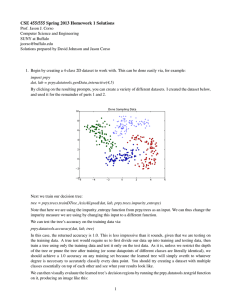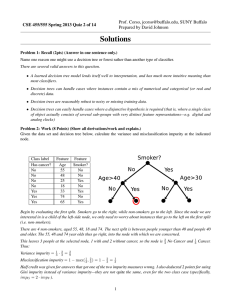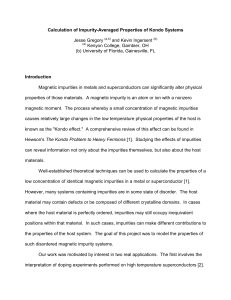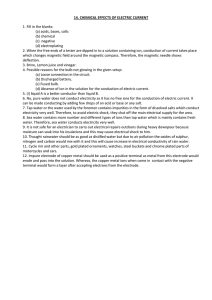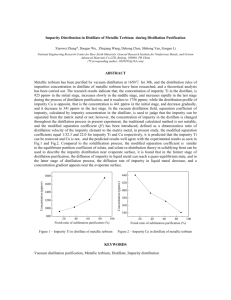Phase Boundaries of the Pseudogap Anderson Impurity Model
advertisement
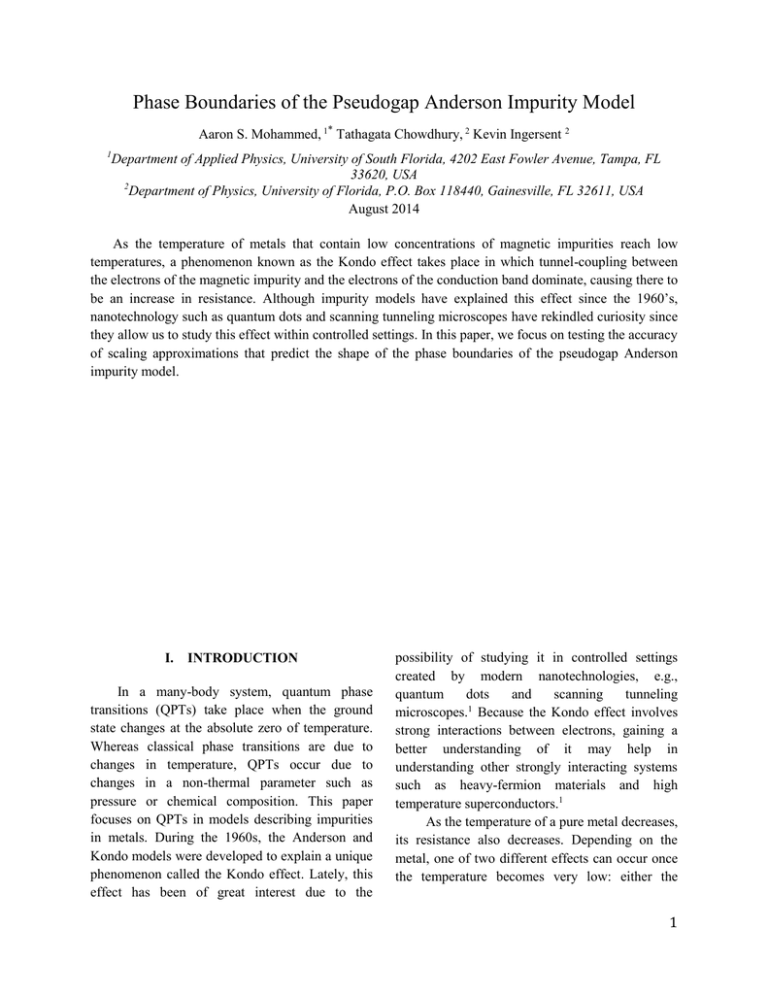
Phase Boundaries of the Pseudogap Anderson Impurity Model Aaron S. Mohammed, 1* Tathagata Chowdhury, 2 Kevin Ingersent 2 1 Department of Applied Physics, University of South Florida, 4202 East Fowler Avenue, Tampa, FL 33620, USA 2 Department of Physics, University of Florida, P.O. Box 118440, Gainesville, FL 32611, USA August 2014 As the temperature of metals that contain low concentrations of magnetic impurities reach low temperatures, a phenomenon known as the Kondo effect takes place in which tunnel-coupling between the electrons of the magnetic impurity and the electrons of the conduction band dominate, causing there to be an increase in resistance. Although impurity models have explained this effect since the 1960’s, nanotechnology such as quantum dots and scanning tunneling microscopes have rekindled curiosity since they allow us to study this effect within controlled settings. In this paper, we focus on testing the accuracy of scaling approximations that predict the shape of the phase boundaries of the pseudogap Anderson impurity model. I. INTRODUCTION In a many-body system, quantum phase transitions (QPTs) take place when the ground state changes at the absolute zero of temperature. Whereas classical phase transitions are due to changes in temperature, QPTs occur due to changes in a non-thermal parameter such as pressure or chemical composition. This paper focuses on QPTs in models describing impurities in metals. During the 1960s, the Anderson and Kondo models were developed to explain a unique phenomenon called the Kondo effect. Lately, this effect has been of great interest due to the possibility of studying it in controlled settings created by modern nanotechnologies, e.g., quantum dots and scanning tunneling microscopes.1 Because the Kondo effect involves strong interactions between electrons, gaining a better understanding of it may help in understanding other strongly interacting systems such as heavy-fermion materials and high temperature superconductors.1 As the temperature of a pure metal decreases, its resistance also decreases. Depending on the metal, one of two different effects can occur once the temperature becomes very low: either the 1 resistance obtains a constant minimum value or it completely disappears, changing the metal’s phase Figure 1: A plot of resistance vs. temperature is shown for a metal that contains a certain concentration of magnetic impurities. Tk represents the metal’s Kondo temperature. to superconducting. As shown in Fig. 1, if the metal contains a very low concentration of magnetic impurities (as low as a few parts per million), it can undergo the Kondo effect where its resistance will actually begin to increase again before finally flattening once the temperature drops far below a characteristic value called the Kondo temperature. The increase in the metal’s resistance arises from the spin-exchange processes that occur between the electrons of the metal and the electrons of the magnetic impurity. 1 Due to quantum fluctuations, an electron in the magnetic impurity can tunnel into an unoccupied bulk state of the metal. Within a very small timeframe, an electron from the bulk state can tunnel into the impurity and take the original electron’s place. If the replacement electron has a different spin value than the original, then the total spin of the impurity will change. These spin-exchange processes increase the resistance because they lead to an increase in scattering, and they eventually lead at absolute zero to the complete screening of the impurity spin by the conduction electrons. 1 The Anderson model is made up of a single magnetic impurity tunnel-coupled to the conduction band of the metal. In order to determine the properties of this system, we need to use the eigenstates and eigenvalues of the entire system. These can be found by using a Hamiltonian that describes the Anderson model. Because this many-body system involves a very large number of terms, second quantized notation is used to represent the Hamiltonian. Instead of representing each individual particle’s state with wave functions, as is the case with first quantized notation, second quantized notation uses occupation numbers that represent the number of particles (𝑛) in a certain state (𝒅). The Hamiltonian for this model is 𝐻𝐴 = 𝐻𝑖𝑚𝑝 + 𝐻𝑏𝑎𝑛𝑑 + 𝐻𝑖𝑚𝑝−𝑏𝑎𝑛𝑑 . (2) In this equation † 𝐻𝑏𝑎𝑛𝑑 = ∑ 𝜀𝒌 𝑐𝒌σ 𝑐𝒌σ (3a) 𝐤,𝛔 describes the conduction band of the host metal, † where 𝑐𝒌σ and 𝑐𝒌σ represents the creation and annihilation operators for a conduction band electron with energy 𝜀𝒌 and spin z-component 𝜎 (which can be either ↑ or ↓ ). When these operators are together, they count the number of such electrons; 𝐻𝑖𝑚𝑝 = U𝑛𝒅↑ 𝑛𝒅↓ + 𝜀𝒅 𝑛𝒅 (3b) represents the magnetic impurity, where 𝑈 is the Coulombic repulsion between two electrons on the 2 impurity level, 𝑑σ† and 𝑑σ are the creation and annihilation operators for an electron with energy 𝜀𝒅 and spin z-component 𝜎 in the impurity level, and 𝑛𝒅 = 𝑛𝒅↑ + 𝑛𝒅↓; 𝐻𝑖𝑚𝑝−𝑏𝑎𝑛𝑑 = V √𝑁𝑘 ∑(𝑑σ† 𝑐𝒌σ + H. c. ) (3c) 𝐤,𝛔 accounts for the tunnel-coupling between the impurity and the conduction band electrons, with 𝑁𝑘 being the number of unit cells in the metal and V the hybridization matrix element. (a) (b) Figure 2: (a) The density of states for a pure metal. (b) The density of states for a semi-metal. In order to represent many-body interactions, such as these, the electronic states of the system would have to be considered. The number of electronic states within a certain range of energy levels can be determined by calculating the density of states. The number of electronic states (𝜌(𝜀)) for a specific energy level (𝜀) is given by 𝜀 r 𝜌(𝜀) = 𝜌𝑜 | | , 𝐷 (1) where 𝐷 is equal to half the bandwidth of the conduction band, which in this paper is 2, and r is a constant2. All of the energy states below the Fermi energy of the metal are occupied, while all of the states above are vacant. For a normal metal, where r = 0, the number of electronic states are the same between any given range of energies. For a value of r > 0 , however, the number of states decreases as the lower energies approach the Fermi energy and then begin increasing again as the energy continues to increase; this is called a pseudogap and is found in semi-metals. The major difference between metals and semi-metals, within the context of the Kondo effect, is that semimetals undergo QPTs while pure metals do not. The two different quantum phases for a semimetal are the local moment (LM) and strong coupling (SC) phases. The magnetic impurity’s spin degree of freedom is free in the LM phase, while it is extinguished in the SC phase due to the Kondo effect, this basically means that the impurity’s magnetic moment is completely screened out by the surrounding electrons. Phase diagrams for the pseudogaped Anderson model have been approximated using a scaling method called poor-man’s scaling analysis. These calculations are only approximations, however, and are not as accurate as numerical calculations. In this project, we decided to test the accuracy of the predictions of the behavior of the pseudogap model phase diagrams developed from the results of the scaling approximations. We did this by using the numerical renormalization group method to make more accurate calculations of quantum critical points and analyzed them to see how well the predictions matched the results. However, the Kondo effect is notoriously difficult to capture using algebraic methods, so the 3 reliability of the predicted phase boundaries is unclear. The goal of this project was to compared the phase boundaries predicted by poor man’s scaling with those obtained via a highly reliable but computationally intensive technique called the numerical renormalization group. Section II briefly describes this method, while Section III presents and discusses our numerical results. knowing what combination of parameters would cause the impurity to be in the LM phase and what combination would cause it to be in the SC phase. At absolute zero, if the impurity is in the LM phase, its magnetic susceptibility, Tχ, would be 1 equal to 4. If the impurity were in the SC phase, Tχ 𝑟 8 would be equal to when the system is in particlehole symmetry or 0 otherwise. In order to solve for Tχ, equation (2) must be diagonalized to obtain all of the eigenstates and eigenvalues of the system. However, this would mean having to consider all of the different electronic states across the bandwidth. As one can imagine, if we do this, our matrix will end up with such a large dimensionality that even a computer would have a hard time solving it. In order to solve this problem, we use the numerical renormalization group (NRG) method that was developed be Kenneth Wilson during the 1970s. What this method essentially does is logarithmically discretize the 𝜀 continuous spectrum of the bandwidth [-1 < < 1] (a) D (b) into positive and negative intervals D+ n = −n −(n+1) [Λ−(n+1) , Λ−n ] and D− ] , n = [−Λ , −Λ where n = 0, 1, 2 … If Λ is taken to be equal to 1, then the problem is unchanged and will take an infinite amount of time to be solved. −Λ0 Figure 3: (a) The phase diagram of a semimetal with 0 < r < ½ (b) The phase diagram of a semi-metal with r > ½ II. METHODS In order to determine where the critical points of the phase boundaries were, we needed a way of −Λ−1 −Λ−2 Λ−2 Λ−1 Λ0 If Λ is set to 2 or 3, however, these intervals get smaller and smaller as the energies gets closer to the Fermi energy. The reason for this discretization is so that only one electronic state is represented in each of these intervals or so called bins. So instead of having an infinite set of states over the entire bandwidth, we only sample one 4 state per bin with an energy that is equal to the average over the bin, weighted by the density of states 𝜀n± = ∫ ±,n ∫ 𝑑𝜀 𝜌(𝜀)𝜀 ±,n 𝑑𝜀 𝜌(𝜀) . (4) by iterative diagonalization. After each iteration, only the eigenstates with the lowest energies are kept. These solutions describe the physics in a temperature range equal to n DΛ−2 Tn = , 𝑘B The energy of each state is now equal to 1 𝜀n± = ± Λ−n (1 + Λ−1 ). 2 (5) The discretized conduction band is mapped via the Lanczos transformation onto a semi-infinite chain form. The Anderson impurity model is now solved III. RESULTS where 𝑘B is Boltzmann’s constant. In order to make these numerical calculations, we used an existing NRG code to repeatedly solve the Anderson impurity model and track Tχ of the impurity vs. T automatically. 𝜀𝑑𝑐 ≈ − A. 𝜺𝐝 (𝐫, 𝐔, 𝚪), r > 1 Log (− The first scaling approximations tested predicted the behavior of thehighlighted portions of the phase boundary for r > 1 shown in Fig. 5. (6) ΓU (𝑟 − 1)𝜋 𝜀𝑑𝑐 ) = Log(U) − Log((𝑟 − 1)𝜋) Γ 𝜀𝑑𝑐 ≈ − Log (− Γ r𝜋 𝜀𝑑𝑐 ) = Log(r𝜋) Γ r 𝜋𝑟 (1 + ) U 1−𝑟 2 Γc ≈ ≈ ( ) r 2 𝑟(1+ ) 2 4𝑒 Figure 5: The red highlighted area shows the portion of the boundary predicted by equation (7). The blue highlighted area shows the portion of the boundary predicted by equation (9). Log(Γc ) = Log ( r 𝜋𝑟 (1 + 2) r 𝑟(1+ ) 2 4𝑒 U ) + (1 − r) Log ( ) 2 5 -8 -6 -4 -2 0 2 4 0 -1 Log (dc/) -2 -3 -4 r = 1.1 r = 1.5 r=2 -5 -6 -7 = 10-3 -8 Log (U) 6 R Γ 10-3 1.1 10-2 10-1 10-3 1.5 10-2 10-1 10-3 2 10-2 10-1 Slope Y-Intercept Predicted YIntercept 9.36E-01 -1.15E-01 5.03E-01 1.17E-02 -6.05E-01 -5.39E-01 9.38E-01 -1.17E-01 5.03E-01 1.17E-02 -6.05E-01 -5.39E-01 9.53E-01 -1.45E-01 5.03E-01 1.13E-02 -6.04E-01 -5.39E-01 9.90E-01 -3.59E-01 -1.96E-01 1.33E-02 -7.41E-01 -6.73E-01 9.90E-01 -3.62E-01 -1.96E-01 1.33E-02 -7.41E-01 -6.73E-01 9.91E-01 -3.91E-01 -1.96E-01 1.30E-02 -7.40E-01 -6.73E-01 9.97E-01 1.47E-02 9.97E-01 -6.02E-01 -8.66E-01 -6.04E-01 -4.97E-01 -7.98E-01 -4.97E-01 1.47E-02 -8.66E-01 -7.98E-01 9.98E-01 -6.22E-01 -4.97E-01 1.45E-02 -8.65E-01 -7.98E-01 7 B. 𝚪𝐜 (𝐫, 𝐔), r < 𝟏 𝟐 𝐔 , 𝜺𝐝 = − 𝟐 -14 -13 -12 -11 -10 -9 -8 -7 -6 Log (c) -15 -5 -4 r = 0.05 r = 0.1 r = 0.15 r = 0.2 r = 0.3 r = 0.4 1 2 d U hhhh -3 -3 -4 -5 -6 -7 -8 -9 -10 -11 -12 -13 -14 -15 -16 -17 -18 Log (U) r Slope Predicted Predicted Y-Intercept Slope Y-Intercept 0.05 0.950012 0.95 -3.74 -3.92 0.1 0.900033 0.9 -2.95 -3.22 0.15 0.850064 0.85 -2.44 -2.82 0.2 0.80011 0.8 -2.04 -2.53 0.3 0.70026 0.7 -1.39 -2.14 0.4 0.600461 0.6 -0.766 -1.87 8 -6.5 -2 -6.0 -5.5 -5.0 -4.5 -4.0 -3.5 -3.0 Log [c(-U/2)-c(Ed)] -3 -4 -5 r = 0.1 r = 0.2 r = 0.3 -6 -7 -8 -9 U = 10-3 -10 Log [Ed + U/2] 9 -3.5 0 -3.0 -2.5 -2.0 -1.5 -1.0 -0.5 0.0 Log [c(-U/2)-c(Ed)] -1 -2 -3 r = 0.1 r = 0.2 r = 0.3 -4 -5 -6 U=1 -7 Log [Ed + U/2] U 10^-3 1 r Slope 0.1 2.015 0.2 0.3 2.000 1.966 0.1 0.2 2.000 2.026 0.3 2.005 CONCLUSION Although there are substantial deviations of our prefactors between numerical results and approximations, these approximations accurately predict the behavior of the phase boundaries of the Anderson impurity model. Therefore, these approximations are accurate qualitatively. IV. V. REFERENCES * Electronic address: amohammed2@mail.usf.edu 1. L. Kouwenhoven and L. Glazman, Revival of the Kondo effect. Physics World 14, 33 –38 Jan. 2001 10
